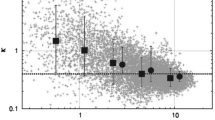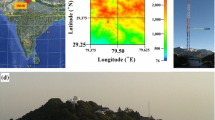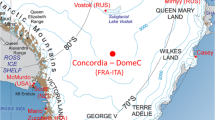Abstract
The diurnal cycle of the mixing ratio MR is discussed for Padova, sited about 30 km from the sea. In the morning a noticeable increase of the MR can be noted until the nocturnal inversion is completely eroded; afterwards convective activity mixes the humid sublayer with dry air aloft, so that an abrupt drop in MR follows the break-up of the inversion; the minimum is generally reached after noon. The minimum is primarily due to the enhanced activity of the thermals at mid day. During the day, increases in wind speed are generally accompanied by the arrival of new air masses, so that no general statements about the MR can be made without knowledge of the local dynamic climatology. Clouds cause an increase in MR, due to the out-of-phase relation between the dampings of the turbulent diffusion coefficient for water vapour and of the evaporation rate of the soil. In the afternoon the MR increases again until after sunset, when the sea breeze (final phase) transports humid marine air inland practically unaltered.
Similar content being viewed by others
References
Blackadar, A. K.: 1962, ‘The Vertical Distribution of Wind and Turbulent Exchange in a Neutral Atmosphere’, J. Geophys. Res. 67, 3095–3102.
Camuffo, D., Bernardi, A., and Bacci, P.: 1982, ‘Computing the Flux of Moisture from Net Radiation and Soil Wetting’, Boundary-Layer Meteorol. (in press).
Elliott, W. P.: 1964, ‘The Height Variation of Vertical Heat Flux near the Ground’, Quart. J. Roy. Meteorol. Soc. 90, 260–265.
Hage, K. D.: 1975, ‘Urban-Rural Humidity Differences’, J. Appl. Meteor. 14, 1277–1283.
McNaughton, K. G.: 1976, ‘Evaporation and Advection II’, Quart. J. Roy. Meteorol. Soc. 102, 193–202.
Nieuwstadt, F. T. M. and Driedonks, A. G. M.: 1979, ‘The Nocturnal Boundary Layer: A Case Study Compared with Model Calculations’, J. Appl. Meteorol. 18, 1397–1405.
Normand, C. W. B.: 1921, ‘Wet Bulb Temperatures and the Thermodynamics of the Air’, Mem. Ind. Meteorol. Dept. 23, 1–22.
Rao, K. S. and Snodgrass, H. F.: 1979, ‘Some Parametrization of the Nocturnal Boundary Layer’, Boundary-Layer Meteorol. 17, 15–28.
Smith, F. B.: 1973, ‘Long Range Diffusion’, in UTSI-VKI Lecture Series, Atmospheric Turbulence and Diffusion and Their Effects on Pollution, Von Karman Inst., Rhode St. Genèse, Belgium, 35 pp.
Weisman, R. N.: 1975, ‘A Developing Boundary Layer over an Evaporating Surface’, Boundary-Layer Meteorol. 8, 437–445.
Author information
Authors and Affiliations
Rights and permissions
About this article
Cite this article
Camuffo, D., Bernardi, A. The diurnal trend in surface mixing ratio at Padova, Italy. Boundary-Layer Meteorol 22, 273–282 (1982). https://doi.org/10.1007/BF00120009
Accepted:
Issue Date:
DOI: https://doi.org/10.1007/BF00120009




